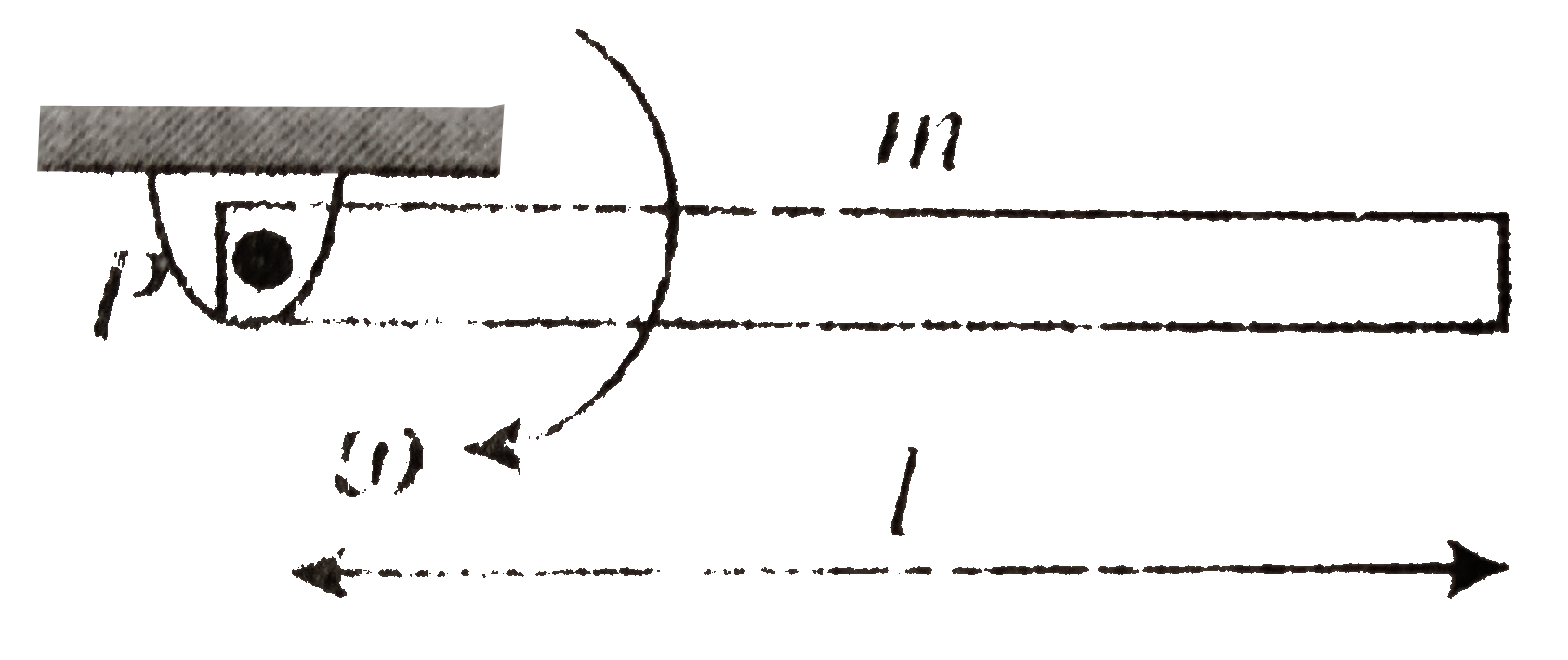The oxygen molecule has a mass of 5.30×10−26kg and a moment of inertia of 1.94×10−46kgm2 about an axis through its centre perpendicular to the line joining the two atoms. Suppose the mean speed of such a molecule in a gas is 500m/s and that its kinetic energy of rotation is two thirds of its kinetic energy of translation. Find the average angular velocity of the molecule.
To solve the problem, we need to find the average angular velocity of the oxygen molecule given its mass, moment of inertia, mean speed, and the relationship between its rotational and translational kinetic energies.
1. Identify Given Data:
- Mass of the oxygen molecule, m=5.30×10−26kg
- Moment of inertia, I=1.94×10−46kg m2
- Mean speed, v=500m/s
2. Understand the Relationship Between Kinetic Energies:
- The kinetic energy of rotation (KErotation) is given to be two-thirds of the kinetic energy of translation (KEtranslation).
- The formulas for kinetic energies are:
- KEtranslation=12mv2
- KErotation=12Iω2
3. Set Up the Equation:
- From the problem statement, we have:
12Iω2=23(12mv2)
- Simplifying this gives:
Iω2=23mv2
4. Solve for Angular Velocity (ω):
- Rearranging the equation:
ω2=23mv2I
- Taking the square root:
ω=√23mv2I
5. Substitute Values:
- Substitute m=5.30×10−26kg, v=500m/s, and I=1.94×10−46kg m2:
ω=√23(5.30×10−26)(5002)1.94×10−46
6. Calculate:
- Calculate 5002=250000.
- Now substitute:
ω=√23(5.30×10−26)(250000)1.94×10−46
- Calculate the numerator:
5.30×10−26×250000=1.325×10−20
- Now, divide by 1.94×10−46:
1.325×10−201.94×10−46=6.83×1025
- Now multiply by 23:
23×6.83×1025=4.55×1025
- Finally, take the square root:
ω=√4.55×1025≈6.7×1012rad/s
Final Answer:
The average angular velocity of the oxygen molecule is approximately ω≈6.7×1012rad/s.
- Mass of the oxygen molecule, m=5.30×10−26kg
- Moment of inertia, I=1.94×10−46kg m2
- Mean speed, v=500m/s
- The kinetic energy of rotation (KErotation) is given to be two-thirds of the kinetic energy of translation (KEtranslation).
- The formulas for kinetic energies are:
- KEtranslation=12mv2
- KErotation=12Iω2
- From the problem statement, we have:
12Iω2=23(12mv2)
- Simplifying this gives:
Iω2=23mv2
- Rearranging the equation:
ω2=23mv2I
- Taking the square root:
ω=√23mv2I
- Substitute m=5.30×10−26kg, v=500m/s, and I=1.94×10−46kg m2:
ω=√23(5.30×10−26)(5002)1.94×10−46
- Calculate 5002=250000.
- Now substitute:
ω=√23(5.30×10−26)(250000)1.94×10−46
- Calculate the numerator:
5.30×10−26×250000=1.325×10−20
- Now, divide by 1.94×10−46:
1.325×10−201.94×10−46=6.83×1025
- Now multiply by 23:
23×6.83×1025=4.55×1025
- Finally, take the square root:
ω=√4.55×1025≈6.7×1012rad/s
The average angular velocity of the oxygen molecule is approximately ω≈6.7×1012rad/s.
Topper's Solved these Questions
- SYSTEMS OF PARTICLES AND ROTATIONAL MOTIONBOOK - NCERT ENGLISHCHAPTER - SYSTEMS OF PARTICLES AND ROTATIONAL MOTIONEXERCISE - EXERCISE
33 Videos
- PHYSICAL WORLD BOOK - NCERT ENGLISHCHAPTER - PHYSICAL WORLD EXERCISE - EXERCISE
16 Videos
- THERMAL PROPERTIES OF MATTERBOOK - NCERT ENGLISHCHAPTER - THERMAL PROPERTIES OF MATTEREXERCISE - EXERCISE
22 Videos
Similar Questions
An oxygen molecule has a mass of 5.3×10−26 kg anda moment of inertia of 1.94×10−46kgm2 about an axis passing through the centre and perpendicular to the line joining the two oxygen atoms. The molecule is moving at a speed of 500 m/s and its rotational kinetic energy is two-thirds its translational K.E. Calculate its angular velocity.
View SolutionThe moment of inertia of a copper disc, rotating about an axis passing through its centre and perpendicular to its plane
View SolutionThe moment of inertia of a circular ring of mass 1 kg about an axis passing through its centre and perpendicular to its plane is 4 kg m2. The diameter of the ring is
View SolutionCalculate the moment of inertia of a ring of mass 2kg and radius 2cm about an axis passing through its centre and perpendicular to its surface.
View SolutionCalculate the moment of inertia of a ring of mass 2kg and radius 2cm about an axis passing through its centre and perpendicular to its surface.
View SolutionA rod of mass m spins with an angular speed ω=√gl, Find its a. kinetic energy of rotation. b. kinetic energy of translation c. total kinetic energy.

View SolutionFind the moment of inertia of a uniform cylinder about an axis through its centre of mass and perpendicular to its base. Mass of the cylinder is M and radius is R.
View SolutionCalculate the moment of inertia of a rod of mass 2 kg and length 5 m about an axis perpendicular to it and passing through one of its ends.
View SolutionThe mass of a uniform circular ring of radius 0.2m is 0.1kg. Calcuate the moment of inertia of the ring about an axis passing through its centre an perpendicular to its surface.
View SolutionIf a constant torque of 500 Nm turns a wheel of moment of inertia 100kg−m2 about an axis through its centre, find the angular velocity and the kinetic energy gained in 2 seconds,
View Solution
